You’d be forgiven for thinking the pedestrian pathway on Haizhu Bridge would be dead quiet at 4am, but you’d be wrong. Every morning, from around 3am until whenever the chengguan show up (usually between 6-7am), the tranquility of nighttime along the Pearl River is broken by the bustle of commerce, with a motley crew of street vendors and antique peddlers setting up shop along the western side of the iconic bridge.
On a Saturday morning back in May, we pulled ourselves out of bed sometime between 2 and 3am to pay a visit to this late-night phenomenon. Known as a ‘ghost market’ to Guangzhou locals, we were tipped-off to the existence of the Haizhu Bridge market by word of mouth.
Admittedly skeptical (and half expecting to find a deserted, dark bridge), we arrived at the river crossing sometime around 4am and were surprised to find a hive of activity. Stretching from Nanhua Dong Lu, in the south, over the entirety of the bridge’s western sidewalk, the first and most famous ghost market on our list was crammed full of buyers and sellers.

Women shifting through used garments on Nanhua Dong Lu at around 4am. Image by Tristin Zhang/That's
Old fishing equipment, Republic of China-era coins, pornographic DVDs, baijiu, a violin with broken strings: the items on offer at the Haizhu Bridge ghost market ran the gambit. Old women sifted through secondhand dresses, mixed amongst heaps of assorted garments. Middle-age men scrutinized jade stones, antiques and old badges under the light of handheld torches, their shadows cast long over the trinkets strewn across the surface of the sidewalk.
We started our early morning shopping excursion at the south side of Haizhu Bridge. On our way up the bridge deck, we encountered a vendor hawking Chinese medicine-related items. As we passed, he bragged aloud about his collection of high-quality mushrooms; in front of him, a copy of American Drug Index (1982) rests amongst a selection of Chinese cookbooks. Also in his possession: a copy of Mao’s ‘little red book,’ an ancient Herica camera, a handbag and a stone grinder for herbs.
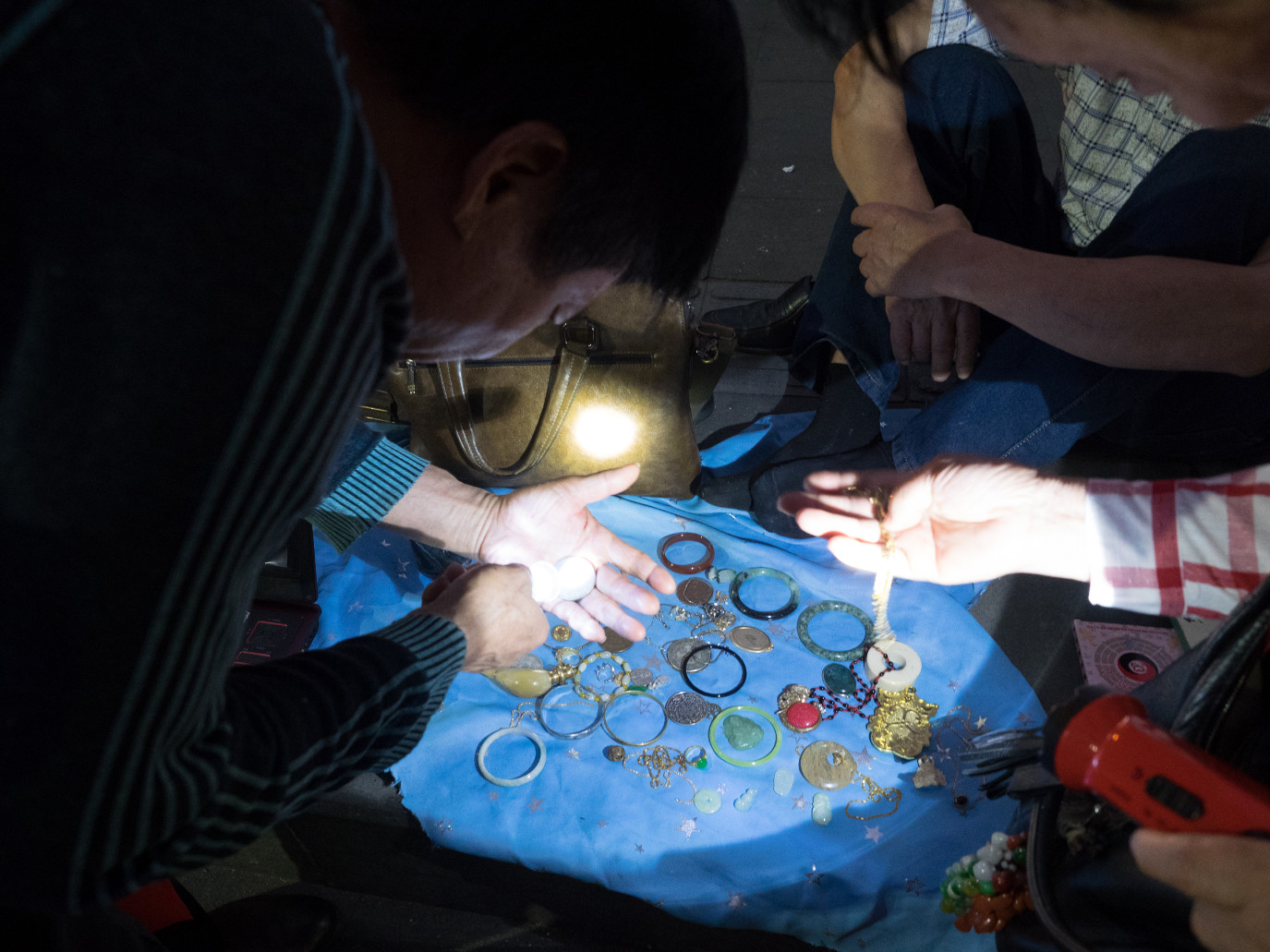 A middle-aged man inspecting an old coin with a flashlight. Image by Tristin Zhang/That's
A middle-aged man inspecting an old coin with a flashlight. Image by Tristin Zhang/That's
As for the prices at the market? Dirt cheap.
We asked Ms. Wang, another vendor on the bridge, the price of a ‘power twister bar’ (a piece of exercise equipment comprised of a metal coil and two grips), to which she replied “8 kuai.”
We made small talk with Wang (in Chinese, gasp!), asking her where she is from.
“Ai ya! He is speaking Chinese? Where is he from?” asked Wang.
“Canada. Vancouver,” we responded in Chinese.
“Vancouver! My friend is living in Vancouver. Her whole family has moved over there,” Wang stated with unbridled enthusiasm. With a smile, Wang told us about her friend who had left China for Canada, before filling us in on the nuances of dumplings – the preferred edible in her home region of North China.
As the hands on the clock neared 7am, traffic on the bridge began to pick up. Around this time, a posse of chengguan arrived at the makeshift market. “Pack up and leave,” they ordered.
 Chengguan arriving to evict vendors from the bridge at around 7am. Image by Tristin Zhang/That's
Chengguan arriving to evict vendors from the bridge at around 7am. Image by Tristin Zhang/That's
The origin of the ghost markets is difficult to trace. Also referred to as ‘tianguang xu,’ or ‘daybreak markets,’ ghost markets generally sell secondhand goods, collectables and antiques (some more authentic than others…). They are the Chinese equivalent of flea markets, but with one important distinction: vendors do not pay rent.
As the name implies, these open-air marketplaces operate, for the most part, during the early hours of the morning, owing to their illegality by city management regulations. Similar markets are also run in Hong Kong and Jiangmen, west of Guangzhou.
Today, there are only two ghost markets left in Guangzhou. In earlier times, there were as many as six of these unique flea markets operating in the old parts of town.
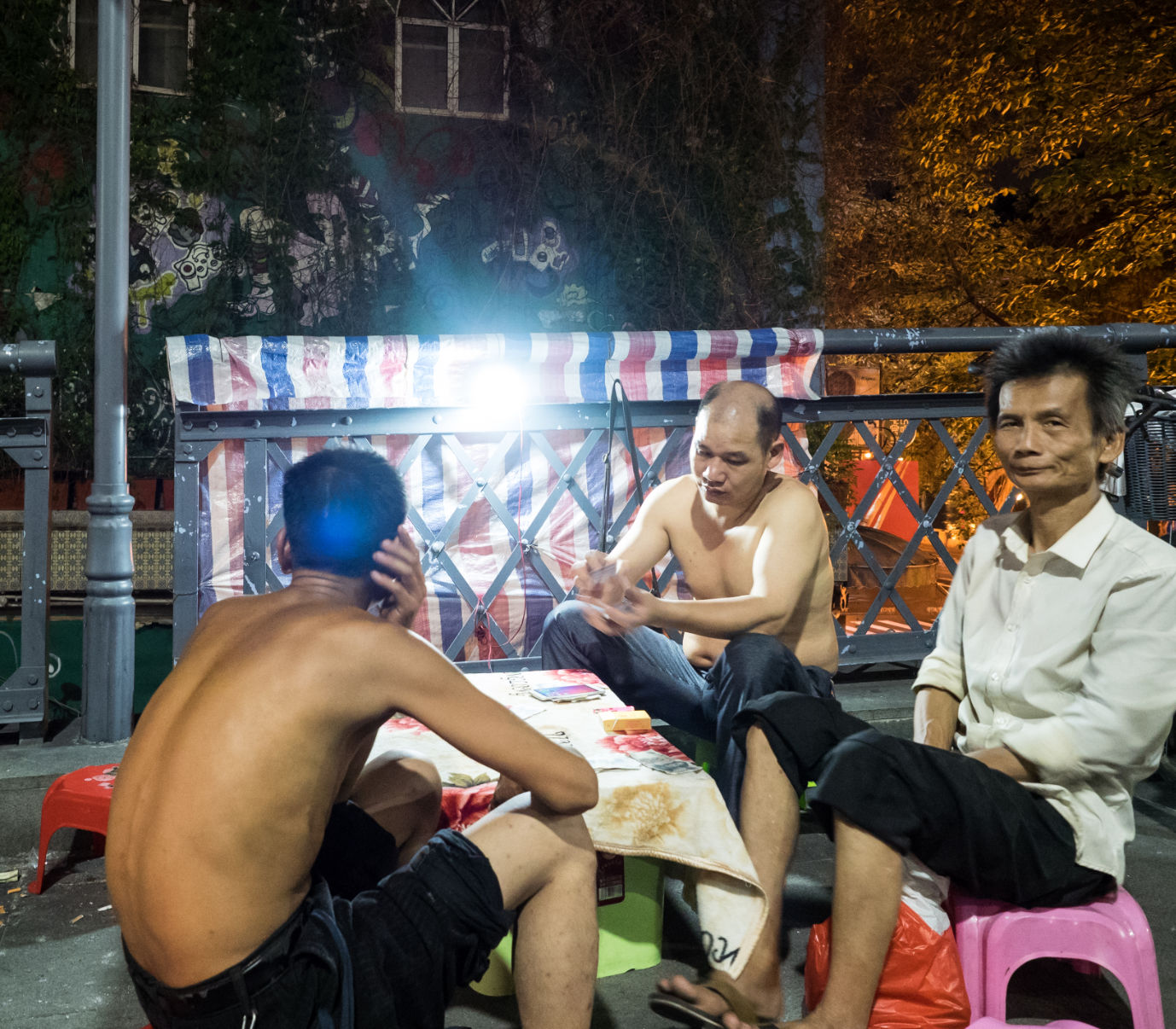 Three hawkers playing cards on the sidewalk of Haizhu Bridge. Image by Tristin Zhang/That's
Three hawkers playing cards on the sidewalk of Haizhu Bridge. Image by Tristin Zhang/That's
The ‘ghost market’ on Renmin Bei Lu, which runs south from Guangzhou Railway Station, closed in October of 2016, but the way it initially came into being is an intriguing story.
“After the Reform and Opening-up Policy, grave robbers from Henan would carry artifacts down to Guangzhou to sell. Because the only train back then arrived in Guangzhou at 3am, they would just sell [the artifacts] on Renmin Bei Lu,” Wu Kaisi told us over early morning dim sum, after showing us around the market on Guangta Lu, where Guangzhou’s oldest mosque is situated.
On our second visit to the Haizhu Bridge market, Wu, 23, served as our guide. A law major graduate from South China University of Technology, Wu is a ‘professional ghost market’ goer who has a passion for vintage, secondhand trinkets. He has been running a daybreak market tour every Saturday (aside from rainy days) for two years.
“Hey, you there!” a vendor called to Wu in a friendly manner as we walked past his post on the bridge deck. With us were two other ‘tourists,’ one of whom locked her eyes on a pair of earrings. In an attempt to barter, the woman asked for the accessories at a much lower price than the given cost of RMB30, irritating the owner, who snapped at the woman in Cantonese. Continuing our confrontational visit to the market, Wu later engaged in a fiery exchange with a shirtless male vendor, telling the salesman to “shut up” as we walked away.
 An old Japanese banknote. Image by Tristin Zhang/That's
An old Japanese banknote. Image by Tristin Zhang/That's
Back in October of 2017, Wu was interviewed by CCTV. The news network was interested in why he chose to become a ‘junkman’ after graduating with a law degree from one of the best universities in China.
While court rooms and legal documents are something Wu has shunned, he does more than just run late-night shopping tours. Wu also operates a vintage store in Xiaozhou village, where a collection of his timeworn collectibles are available for purchase. In his house near the shop, Wu’s living room is chock-full of bizarre items, from African masks, old books and aged porcelain, to old cameras, Buddha figurines and boom boxes.
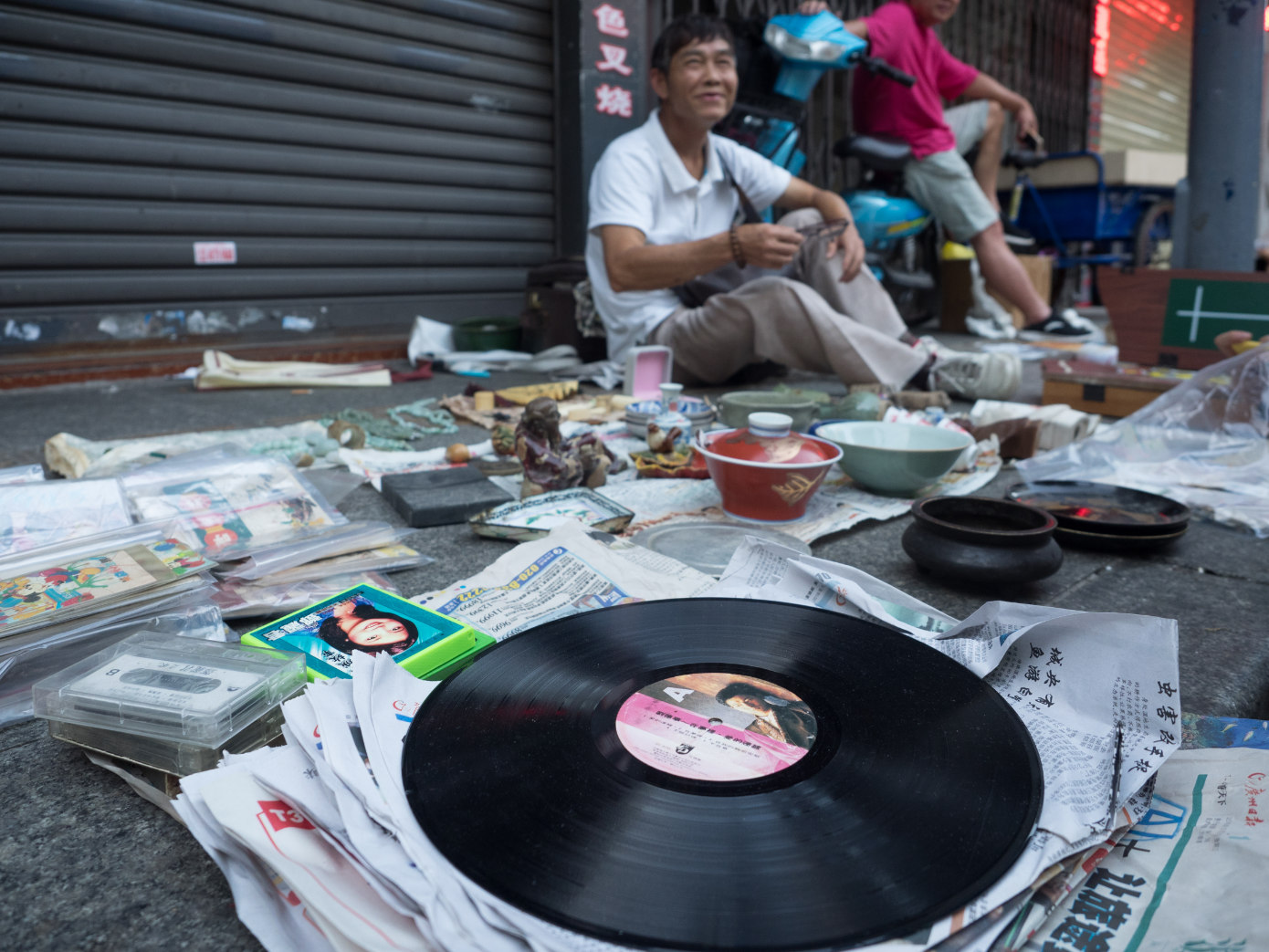 On Guangta Lu, there's no shortage of vendors selling old vinyl records and cassette tapes. Image by Tristin Zhang/That's
On Guangta Lu, there's no shortage of vendors selling old vinyl records and cassette tapes. Image by Tristin Zhang/That's
According to Wu, the vendors on Haizhu Bridge are a mix of vagrants, scavengers, antique resellers and “those who sell gold bricks,” otherwise known as folks selling high quality knockoffs at rock-bottom prices. During our visit to the bridge with Wu, he purchased himself a pair of fake Nike shoes at the wallet-busting cost of RMB2.
Vendors at the Haizhu Bridge market only gather on the west side of the river crossing, owing to the fact that the opposite side of the bridge is under the jurisdiction of Yuexiu District. The west side is under the authority of Haizhu District. If the vendors decided to open shop on the east side of the bridge in addition to the west, it would mean dealing with chengguan from both districts and a complicated regulatory process.
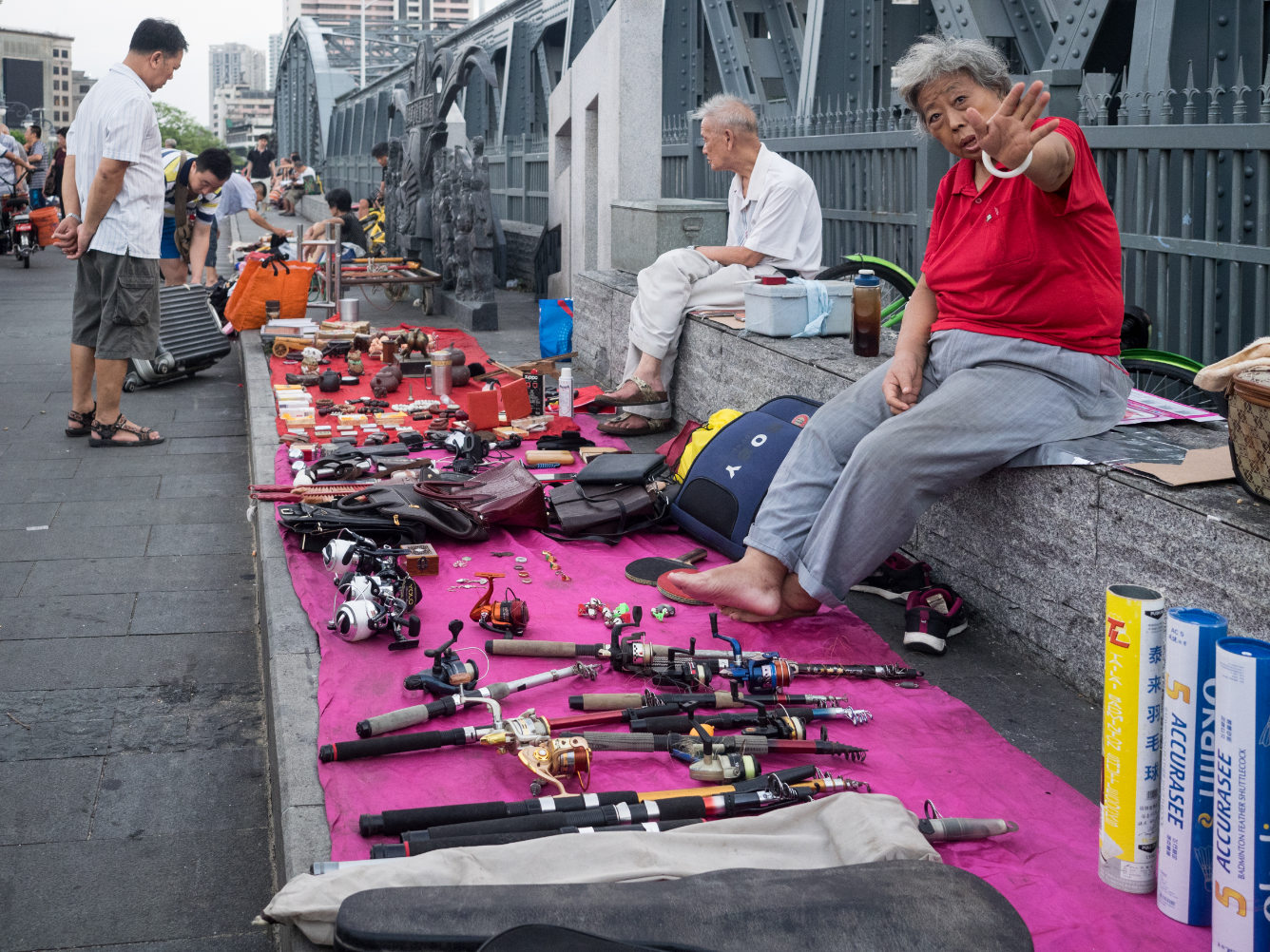 A woman selling fishing gear on Haizhu Bridge. Image by Tristin Zhang/That's
A woman selling fishing gear on Haizhu Bridge. Image by Tristin Zhang/That's
Tolerated until 8.30am each morning, the Guangta Lu market in Liwan District is more self-regulated, with the majority of vendors consisting of antique shop owners (which, we might add, means higher prices). From old books, sketches and Chinese ink paintings, to old coins, vases and pornographic posters, the material scope of this market doesn’t fall short either.
When we visited the Guangta Lu market, vendors were lined up on both sides of the street, as well as the adjoining Haizhu Zhong Lu. As we were examining some old Yuan Shikai coins, Wu came over and patted our shoulders, a sign to inform us that the ‘vintage’ coins were not real.
“This market is a platform where buyers and vendors get acquainted with each other,” Wu told us, noting that he has met and befriended several like-minded individuals at the Guangta Lu market.
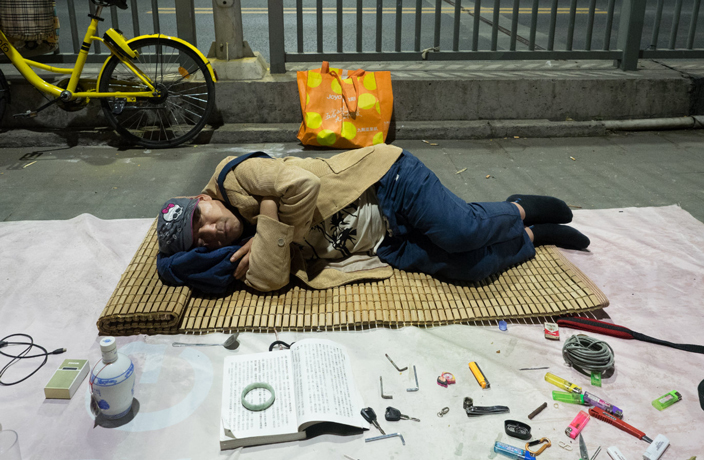
A vendor sleeps on Haizhu Bridge. Image via Tristin Zhang/That's
For city management officials, the ‘ghost markets’ are clearly a nuisance, a ‘tumor’ to be removed from the city’s streets. For the vendors, however, the markets are a place they can make a living, and be part of Guangzhou’s cultural heritage. For us, the thrifty shopper, the markets serve as a real-life ‘Treasure Island,’ where the chance to discover something truly special brings us back time and time again.
[Cover image by Tristin Zhang/That's]





















0 User Comments